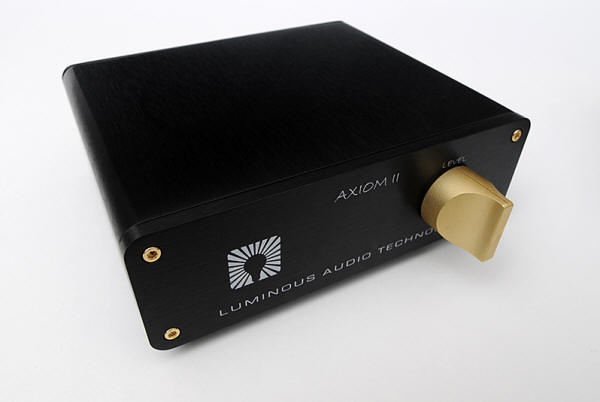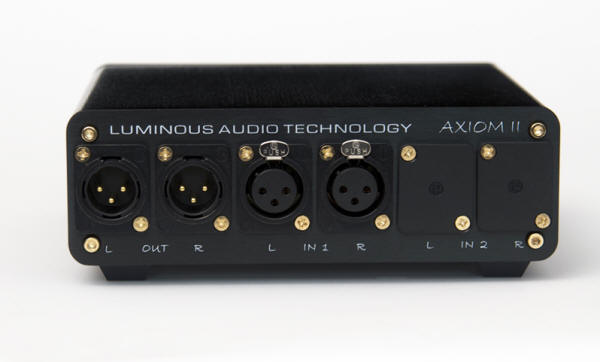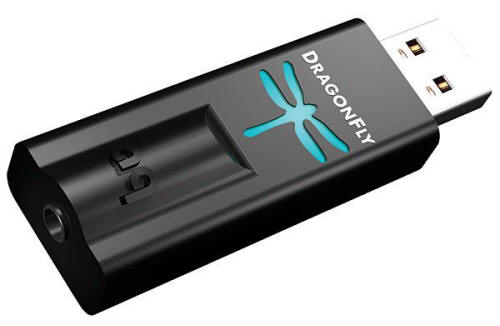|
You are reading the older HTML site
Positive Feedback ISSUE 67
Audio Ramblings - The Axiom Passive, Dragonfly DAC,
and Quad Braid USB Cable
Axiom II Passive Preamp Fully balanced/XLR version from Luminous Audio ($349) It is always such a joy to find items in the high-price world of audio that are not so high-priced and still get you so much of what one can expect when handing out serious coin. Case in point: the Axiom II Passive Preamp Fully balanced/XLR version from Luminous Audio ($349 as configured, one has many options of inputs - RCA - pots and wiring). Now passives have a bad rap, and for many reasons, these justifiably so. Yeah, they do not ‘pre’ the signal in terms of amplifying, treating, coloring, or whatever; so pretty much what goes in is what comes out—there is not much inside to do much of anything to the signal, good or bad. Sure there are connections, wire, switches, and a volume pot—all of varying quality and worth—but the signal is passed through a passive device for minimal effect.
Simple to make, cheaper to make, easier to make… well to a point that is. The problem is getting the parts in the passive to have as little impact on how well the output impedance of the source and the input impedance of the amplification play together. Active preamplifiers deal with this actively making any source’s output impedance a moot point to the input of an amplifier. Passives just pass it along. In many cases, the option of adding a resistor to the signal path inside the passive addresses this to a degree—but it is never a perfect world. Best case is to have a quality source with a decent enough output impedance to drive an amplifier with a benign impedance, and then match them as best as one can with the a passive fitted with a resistor to do what it can. Worst case you lose some dynamics, slam, bass drive, and so on. Best case what you lose is all rather moot—that is, it is not enough to be an issue.
This is what you get with the Axiom units… nice deal Tim! Drop it in and wow, you get music. Music that has so little missing in terms of what passives are reputed to omit… or commit to the signal. I love this little guy. Placed between the Playback MPS-5 and my Clayton M200s with PAD Proteus Provectus XLR cabling (1.5m from the MPS-5 to the Axiom and 3m to the Claytons) I experienced dynamics, slam, bass extension and impact, sweet extended treble, dimensional images, and a wonderfully rich and textured midrange. I get my music and in a way that I am hard pressed to say that I am missing much, if anything. Of course doing side by side comparisons requires changing cables, letting the tubes and amps warm up, and so on… so quick comparisons are difficult. My point is that just using the Axiom… well I can listen for hours and never sit there questioning what is wrong or what is missing. The music plays, the system sings, and I am happy. But come on Clark, there has to be trade-offs? No doubt. When I have taken the time to compare the Axiom directly to the Cary SLP-05… and what a PITA that is, but we be audio reviewers so we must do the component shuffle… sure it can’t do what the Cary does: that oh so sweet tube presence and warmth, greater dynamics, wow slam, deeper bass extension and control, and so on and so on. The Cary is doing what an active preamp is supposed to do—maximize the output from a source to meet the input of an amplifier. So yeah, I bought the Cary just because it does that so well with the Claytons—they are a perfect match for my music, my preferences, my speakers… and so on. Synergy perfected absolute. Differences are there, but not to a point that makes me toss the Axiom across the room and pity the fool who thinks passives are the way to go and actives are the tools of the forsaken. Sorry man, the Axiom is quite nice, does what it does for so little cash, and yes, it makes my music play. Sure, mine has only 1 input which makes it difficult to use, sure it is not the best option for analog users unless your phonostage is robust and a good match for your amplifier… and so on. No need to nitpick, I love the Axiom and cannot recommend it any higher for those who find the want of passive as opposed to an active preamp with more options and inputs than they will ever need. Give it a try! Perfect for those who are computer-based with a quality DAC. Damn… that is how I used it here! http://luminousaudio.com/axiom2/bal.html
Audioquest Dragonfly USB DAC ($249.98) This little thing (and it is little, being the size of a USB flash drive) is quite amazing. It does so much right and so little wrong—well not so much wrong in terms of committing, but more about omitting or falling short when compared to pricier USB or for that matter, non-USB DACS—that it is a real head scratcher. How can they get so much to happen inside such a little dongle-like DAC? A headphone amplifier, 24/96 DAC (uses the ESS Sabre chip), and preamplifier. It brings to mind the classic science fiction flick Fantastic Voyage, where all this technology in the form of a submarine is miniaturized to be injected inside a person in hopes of saving their life. Oh, and it featured a very young Raquel Welch. Way cool… way ahead of the time. Sort of like the Dragonfly… all these things miniaturized to save you time, money, space, while making your life better. Better in one major way—enjoying your music. Easy to use (plug and play), easy to travel with (no USB DAC box to fumble with, no power supply to haggle with, and no headphone amplifier to wrangle into place), the Dragonfly simply slips into an available USB slot on your PC and away you go. Sure, it is not going to give you all that an external DAC feeding an external headphone amplifier - either or both powered from some esoteric power source (or generic for that matter)—all connected with cabling costing more than the Dragonfly itself. But it will make you not give a rat’s ass if it isn’t doing all that. Not that I see this as the Dragonfly's intended use… to replace the hardcore headphone/computer gear heads esoteric traveling kit—let alone theirs at home! The Dragonfly is more about simplicity, lifestyle, traveling light… while still getting your music from a file on a PC to your headphones for you to enjoy. Yeah, it ain’t a pile of pricey boxes. It is, though, a pile of less-pricey boxes shrunken down into a manageable device that works. It works, it makes music, and it sounds very good. Can it drive any and all headphones? No, of course not. Best to use an easier load ‘phone than say those that are a more difficult load or require more drive to come alive. Worked great with my Sennhieser HD600, but not as good on my Audeze LCD-3 phones (great phones by the way!)—which is what one would expect with their differing needs in terms of drive and whatnot. Ditto with going directly an amplifier. I tried it and yes it works, but is not the best use of the Dragonfly, nor do I see it as intended application. You lose a lot trying this and for me at least, it did not work. But using directly to drive headphones into the Cary and yes, it plays music and sounds wonderful. As good as the MPS-5? Uh, no, not even close. But then I am not going to be carrying the MPS-5 around when I travel either! Audioquest has a clear winner in the Dragonfly. If you need to read more about it, well there are many comments and reviews on the web, check it out. Like anything, different strokes for different folks. The Audioquest Dragonfly is not going to float everyone’s boat… for me, the Dragonfly is a rather nice sail. http://www.audioquest.com/usb_digital_analog_converter/dragonfly-dac
Quad Braid USB cable from Elijah Audio ($200) This cable is based on double twisted pair wire geometry (Audience Cryo copper wire) inside a tight cotton tubing (to control micro vibrations and uses Peter Belt (PWB) products). What you get is a musically engaging sound that falls more to the forgiving side as opposed to the neutral or analytic side. This is not a cable that will reveal all that is there in the way that draws attention to itself, nor will it cause you to chew on glass… the Quad Braid is slightly more euphonically rich and forgiving than say the offerings from Nordost and many others. They are all wonderful products, but for those who appreciate what USB cables can do… they each bring something different to the table. I like this cable a lot, and when paired with, say the iFi USB Power, and say a more upfront cable, you get nirvana.
At this price you get a wonderful product. This is a musically engaging cable that offers the listener a richer more forgiving sound that draws one into the music. It is not a cable that throws the music at you… grabbing you by the collar and yelling you to listen to me! No, like the best in tubes, the Quad Braid makes music. http://www.elijahaudio.com/products.html
|






